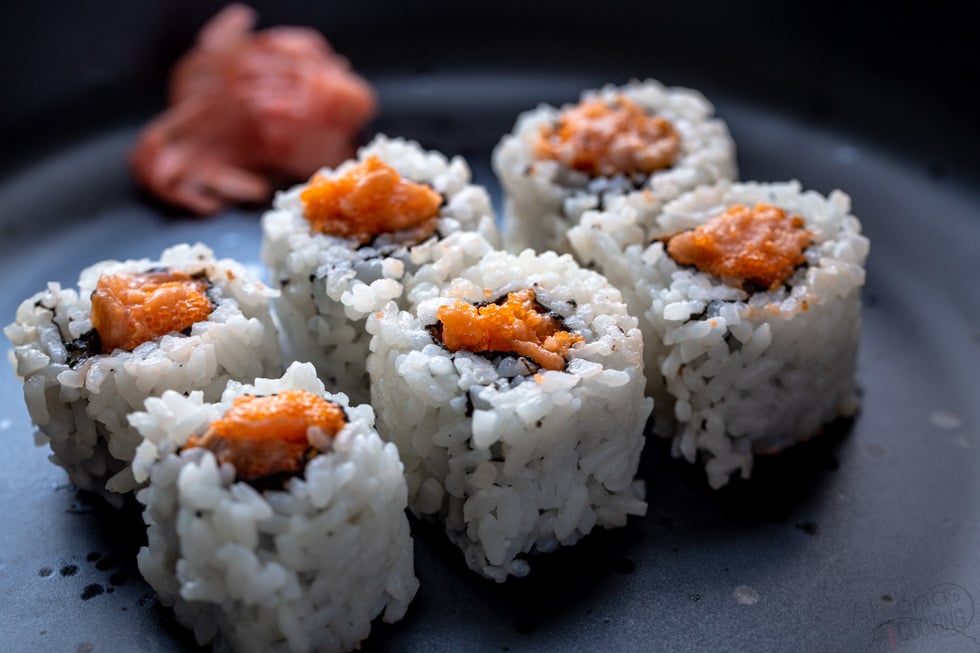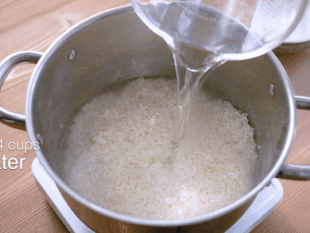The only Sushi Rice Recipe I make for rolls! This Japanese-style sushi rice is sticky, perfectly seasoned, and flavorful!
I’ve been making this easy sushi rice for about a decade now, ever since sushi became a thing. It’s the base for a good sushi rice bowl and makes many homemade sushi rolls for a fraction of what you’d buy at a Japanese restaurant.

Our family’s favorite way to eat sushi rice is in these Philadelphia Rolls and Spicy Tuna Roll!
Lately, I’ve been making a Sushi Bake, which is basically layering the sushi rice and all of the sushi toppings into a casserole dish for an easy hack to a deep-fried roll.
Our family loves sushi! There has even been a time when I didn’t have rice vinegar on hand, so I came up with a Rice Vinegar Substitute by using apple cider vinegar (it works).
What is Sushi rice?
If you’d had sushi at a Japanese restaurant, you’ve eaten sushi rice. Sushi rice is sticky rice used to prepare many Japanese dishes, including sushi rolls, Sashimi Rolls, and rice bowls.
My sushi rice seasoning is basic. I simply use salt, sugar, and apple cider vinegar or sushi rice vinegar, depending on what I have on hand.
What makes the rice sticky depends on the rice you use.
Best Rice for Sushi:
I’ve found that the best sushi rice can be bought in Walmart! Calrose rice is the only rice I’ve used for making sushi at home for over a decade! Lundberg brown rice can be used for a whole-grain sushi rice, but you will need to cook the rice for much longer. Any short-grain rice is ideal for making sushi rice, so don’t stress about sushi rice brands.
How To Cook Sushi Rice?
Overwhelmed by the cooking techniques? Instant pot, stovetop, rice maker, etc? I used to only make this over the stove top, but have discovered that the instant pot is the easiest way to make sushi rice hassle-free. I don’t own a rice cooker, but I find the Instant Pot to be like one.
Instant Pot Sushi Rice:
If you own an Instant Pot, you can easily make this sushi rice recipe! I’ve even added the seasonings right in with the water for a lazy approach, but it’s preferred to season the rice after it cooks.
Sushi rice in the Instant Pot is easy, simply throw the uncooked rice and water into the Instant Pot and press the rice button. After its done, let it depressurize for 15 minutes and fluff up with the rice seasoning, easy as that!
How To Season Sushi Rice?
First, you cook sushi rice. While that cooks, all you need to do is dissolve the sugar and salt in the rice vinegar and toss it with the cooked rice.
How much rice vinegar for sushi? A good rule of thumb is to use 1/3 cup of sushi vinegar for every two cups worth of rice.
Mise en Place
Equipment:
Sushi Rice Ingredients:
- Any Japanese short-grain rice: I use Calrose rice, which is used in Japanese-American cuisine and is suitable for making sushi. A Japanese Chef recommends Japonica rice; the water-to-rice ratio would remain the same.
- Water—My sushi rice-to-water ratio is 1:1.33, which is a little over a cup-to-cup ratio. I’ve even added a quarter cup more water than my recipe, and it still turns out every time!
- Seasoning: To make it taste like Japanese Restaurants, add 1/3 cup of rice vinegar, three tablespoons of sugar, and one teaspoon of salt.
Pro Chef Tip
Pro-Tip: A good sushi rice ratio is 1:1 water to rice (by volume). This ratio is slightly less than the typical 1.2:1 that is often used for regular steamed rice. Sushi rice needs to be slightly drier to absorb the additional moisture from the sushi vinegar.
How To Make Sushi Rice:
Making sushi rice requires minimal equipment. All you need is a medium saucepan or pot and a wooden spatula to get started. I used to triple or quadruple this recipe and it always turned out.
- Rinse the rice a few times to remove the starch from the grains.
- Add cold filtered water and the rinsed rice to a pot.
- Cook the rice: Bring to a boil, reduce the heat, and cover it with a lid to cook it on low for 15-20 minutes.
- Once the rice is cooked, take it off the heat and allow the rice to steam.
- Make the sushi vinegar mixture by heating the vinegar with the sugar and salt until it completely dissolves.
- Transfer the cooked and steamed rice into a large bowl and fold in the rice vinegar mixture.
- Cool the sushi rice to room temperature before using it in sushi roll recipes. Using warm sushi rice can make the Nori Seaweed sheets soggy.
Pro Chef Tip
Pro tip: Be sure to use unseasoned rice vinegar. Some sushi vinegars are already seasoned with salt and sugar, so be careful not to overseason the sushi rice without reading all ingredient labels first.
Q&A
Is Calrose Rice Sushi Rice?
Calrose rice is a sticky short-grain rice suitable for making sushi.
How To Make Sticky Rice for Sushi?
Short-grain rice cooks to a sticky texture, making white short-grain rice ideal for making sushi.
Is Sushi Rice Gluten-free?
In general, rice is naturally gluten-free, including Calrose rice (which is what I use for making sushi).
Tips:
- Sushi rice is a very sticky rice. Always keep a bowl of cold filtered water nearby to dip your hands when working.
- Clean up is easy if you place the bamboo mat in a gallon-sized freezer bag or wrap it in clear plastic wrap.
- Out of Rice Vinegar? That is no problem. Apple cider vinegar works as a great substitute!
- Use a rice cooker or the Instant Pot for an easier way to make sushi rice, as you don’t have to babysit the stovetop.
- Try to use up your sushi rice in dishes on the same day you prepare it. As leftover rice dries and hardens when refrigerated. I will typically make all my sushi rolls on the day of making my sushi rice, that way I can refrigerate leftover sushi rolls but I’m not working with the rice anymore.
- When mixing the seasoning into the rice, turn on a fan nearby to fan out the steam. This helps the vinegar mixture to be absorbed better into the rice.
- To flavor the vinegar mixture with umami flavors, you can make the sushi vinegar a day ahead with a sheet of Kombu (dry seaweed).
How to Prepare Sushi Rice:

Sushi Rice Recipe
Equipment
- 1 medium or large pot
- 1 wooden spatula
- 1 large mixing bowl (ceramic or plastic)
- 1 small saucepan (for making the rice vinegar seasoning)
- 1 sieve or colander to rinse the rice
Ingredients
Ingredients:
- 3 cups short-grain rice (I use Calrose rice)
- 3 1/4 cups cold water
- 1/3 cup rice vinegar (see substitute)
- 3 TBSP granulated sugar
- 1 tsp salt
Instructions
Directions:
- Place the rice in a large fine mesh sieve or colander. Rinse the rice under cold water until the water runs clear.
- Put the rinsed and drained rice into a large pot and add the cold water; bring it to a boil, reduce the heat to low, and cook covered over low heat for 20 minutes.
- Once the rice is cooked, turn off the heat and leave the rice to steam for 15 minutes.
- Meanwhile, in a small saucepan, dissolve the sugar and salt in the rice vinegar over high heat just until the granules dissolve. Set aside.
- Transfer the cooked rice to a large bowl or dish. You can also leave it in the pot it was cooked in. Pour the seasoned vinegar mixture over the rice and quickly fluff it with a wooden spatula to coat it well.
- Cool the sushi rice to room temperature before using it in recipes like sushi rolls. Enjoy!
Notes
- Rice vinegar substitute- you can use an equal amount of apple cider vinegar with hardly any difference. Depending on the color of your apple cider vinegar, it may slightly tint the rice but the taste will be the same.
- This recipe yields 5 cups of cooked sushi rice.
- Cool the sushi rice to room temperature before using it in sushi rolls. Using warm rice can make the seaweed sheets soggy. Spread the sushi rice into a wider dish to thin it out for faster cooling.
- Start the cooking process with cold water for even cooking.
Nutrition per serving





















